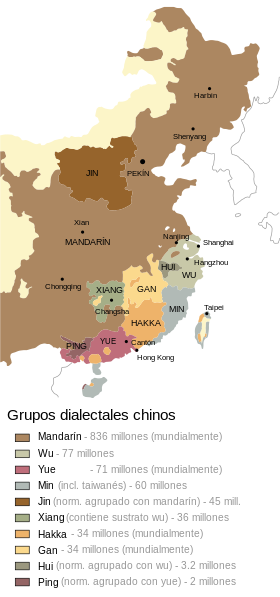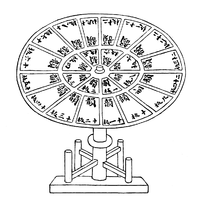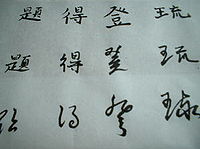Chinese language

The Chinese language (Traditional Chinese 漢語; Simplified Chinese 汉语; pinyin, Hànyǔ, "language of the Han") (IPA for Mandarin: [xânɥỳ]) is the term used to refer to the Sino-Tibetan language that represents, under an agglutinating concept, what is actually a branch of languages that are related to each other but are not mutually intelligible, the Sinitic languages, being the Mandarin language in its pekingese variant the form used as the pattern of Chinese. The Sino-Tibetan family originates from the Central China Plain, and is the major language family among the languages of Asia. More occasionally the term "Chinese" to also refer to other Sinitic languages of China other than Standard Mandarin (“普通话” Pǔtōnghuà (IPA: [pʰùtʰʊ́ŋxwâ]) 'common speech').
Historical, social and cultural aspects
The term "Chinese"
Most of the time the term “Chinese” refers to Standard Mandarin or “pǔtōnghuà”. The term "Chinese" is sometimes used to refer properly to the whole of Sinitic, which encompasses a large family of closely related languages, also known academically as the Sinitic languages.
Standard Mandarin in China is more often referred to as hànyǔ 汉语 / 漢語, although names such as huáyǔ are also used 华语 / 華語 or Zhōngwén 中文. Although there are other native names for the Chinese language. In the People's Republic of China (PRC) the name hànyǔ is also used 汉语 / 漢語 «language of the Hàn». On the other hand, the standardized learned form of the language is usually called pǔtōnghuà 普通话 / 普通話 “common speech” in the PRC, while in Taiwan it is known as guóyǔ 國語 'national language'.
In Spanish, in general, the term "chino" refers to the standard language, although sometimes the term Mandarin is used to refer to it when one wants to distinguish it from dialectal forms. The designations "Mandarin" or "pǔtōnghuà" should be used with caution, as they can also refer to the mutually intelligible dialects spoken in North, Central, and Southwest China.
Standard Chinese
The standardized form of Chinese spoken today is the "general language" (普通话 pǔtōnghùa), also called the "national language" in Taiwan (國語 guóyǔ (AFI: [ kwɔ̌ɥỳ])). A third term to refer to the standard language is "Huaxia language" (華語 / 华语 huáyǔ), used mainly in Singapore, Malaysia and other parts of Southeast Asia. In Spanish it is Standard Mandarin (标准官话, pinyin: biāozhǔn guānhuà (AFI: [pjɑ́ʊ̯ʈʂwə̀n kwánxwâ])), based on the northern dialect, and Peking pronunciation, This language is originally based on a variety of Mandarin spoken during the Manchu dynasty in Beijing. This language was later adopted as an official language of the People's Republic of China and Taiwan, as well as one of the four official languages of Singapore. It is also one of the six official languages of the UN.
Until the beginning of the XX century, the use of Classical Chinese or more exactly a form of literary Chinese based on Classical Chinese had been common. (old Chinese). That classical Chinese, like other classical languages such as Latin, differed markedly from the colloquial or vernacular varieties of Chinese (similarly, in Europe during the High Middle Ages many documents were written in Latin and this differed markedly from the Romance languages used by ordinary people).
Use and status
The percentage of use of Standard Mandarin, the official language/dialect of mainland China, among people aged 15-29 is 70.12% (the percentage in the city and among the more educated population the percentage Is higher). However, with people between the ages of 60 and 69 the percentage is 30.97% (in 2007.) This reflects an important shift in two generations in favor of the standardized national language.
There is a quite popular phenomenon and that is that the Chinese use two dialects or two languages together, the standard and the other mother tongue. Meanwhile, overseas Chinese use more local dialects from their place of origin, usually from the southeast coast from China (Guangdong, Fujian, Zhejiang, Hainan), where they are quite strong.
Sinitic languages
In addition to standard Chinese, used as the official language and lingua franca throughout the country, there are a significant number of regional languages. Many of these regional languages, traditionally called "dialects", differ so much from standard Chinese that they have poor intelligibility with it, so if we use the intelligibility criterion (which is not the only existing criterion from a linguistic point of view for determine whether or not a spoken variety belongs to the same language) would constitute different languages, with which all of them, together, would form part of the same family of linguistic varieties, known as the sinitic family, which have a somewhat higher degree of diversity to that which exists between the Romance languages. All varieties of Chinese or Sinitic languages are characterized by their internal diversity, although all possess tone and have a highly analytical grammatical structure. However, the set comes to differ enormously with respect to the phonological and lexical inventory.
There are between six and twelve Sinitic languages, in addition to Standard Chinese (the number depends on which classification scheme is taken). These languages are generally mutually unintelligible, although some (such as the Xiang and Southwestern Mandarin dialects) may share terms and some degree of intelligibility. Ethnologue somewhat confusingly classifies the Sinitic languages as one macrolanguage with thirteen sublanguages in IS 639-3. Some 1.2 billion people speak some form of Sinitic as their native language.
Of the Sinitic languages, the most demographically important is Mandarin Chinese (850 million speakers) called simply "Chinese", which is the variety on which Standard Chinese is based. Next in importance are the Wu language (77 million), the Min language (70 million), and the Cantonese language (55 million). Standard Cantonese is common and influential in overseas Cantonese-speaking communities, and remains one of the official languages of Hong Kong (along with English) and Macao (along with Portuguese). Southern Min, part of the Min language group, is widely spoken in southern Fujian, Taiwan, and Southeast Asia.
A complete classification is as follows:
- The speaks of the North or Mandarin (translation sterling/ sterling) 836 million speakers. Officer throughout the territory of the People ' s Republic of China.
- The Ow! (severalty /.γ), 77 million.
- The dialects mgiln (severalty / oriented, 70 million).
- The Cantone or yuè (several /.γ), 55 million.
- The jin (several /.γ), 45 million.
- The Language or Hunan (several seconds / αγ, 36 million).
- The hakka or kèjiā (accessive value / witt engaged in the same), 34 million.
- The gàn (several /.γ), 31 million.
- The huī 3.2 million.
- The pínghuà (target sterilization / clincher), 3.5 million.
Mandarin Dialects
The Mandarin dialect block is the most widespread, in the center, southwest, northwest and northeast of China, which is why it currently serves as the basis for defining the standard language. Due to the important extension that this dialectal block reaches, there is regional variation.
There is great phonological variation within Mandarin, both in segmental phonology and in the realization of tones. The following table reproduces some of the personal pronouns:
| Standard Beijing | Mandarin SE Yángzhōu | Mandarin NE Xī'ān | Mandarin SW Chéngdū | Central Mand. Língbăo | |
|---|---|---|---|---|---|
| 1.a sing. «I» | uo3 | or3 | ▼3 | Русский3 | Русский3 |
| 2.a sing. «you» | and3 | li3 | and3 | and3 | and3 |
| 3.a sing. «he/she» | tha1 | tha1 | tha1 | tha1 | tha1 |
| 1.a sg. gen. «my» | uo3 t | or3 ti | ▼3 ♪ | Русский3 and2 | Русский3 ♪ |
| 1.a plural "we" | uo3 møn | or3 mθ | ▼3 m | Русский3 and2 | Русский3 m |
Linguistic description
This section refers to standard Mandarin. The rest of the variants are dealt with in the corresponding articles.
Phonology
The syllable in Chinese distinguishes between an obligatory consonantal initial attack, a possible medial approximant between the attack and the vowel or diphthong that acts as the syllabic nucleus, an obligatory syllabic nucleus, and a possible final that is a nasal or an approximant.
The inventory of Modern Standard Mandarin Chinese is given by (between < > the spelling transcription used in the pīnyīn system is given):
| Bilabial | Labiodental | Alveolar | Retrofleja | Alveo-palatal | Velar | |||||||
|---|---|---|---|---|---|---|---|---|---|---|---|---|
| Nasal | m . m ▪ | n . n ▪ | Русский . ng ▪ | |||||||||
| Occlusive | p . b ▪ | ph . p ▪ | t . d ▪ | th . t ▪ | k . g ▪ | kh . k ▪ | ||||||
| Africada | ts . z ▪ | tsh . c ▪ | .zh▪ | hh .ch▪ | tɕ . j ▪ | thh . q ▪ | ||||||
| Fridge | f . f ▪ | s . s ▪ | . sh ▪ | ())1 . r ▪ | . x ▪ | x . h ▪ | ||||||
| Approximately | l . l ▪ | 1 . r ▪ | j . and ▪ | . -Uh. ▪ | w . w ▪ | |||||||
- /// often transcribed []] (a sound retroflex fricative), although this different transcription of the fonema is due to some variation among the speakers, in fact both alophones should be regarded as the same phone.
The vocálico inventory includes: /i, e, a, o, u, y/ (the vowel /y/ is transcribed as ≤30.00 or ≥-u-give) according to the context. The vowel /a/ is usually articulated as [a] although next to palatal can be pronounced as [e], fonema /e/ presents an important alophonic variation [,,,, 국]. In addition there are four different shades that are phenomically distinctive.
Grammar
Chinese has little morphology, making it simpler in that respect than English or Spanish. Chinese also has no gender or number changes, except for some marginal plural forms in personal pronouns. This also occurs in other Asian languages, such as Japanese.
Verbs do not vary according to person, number, or tense. The perfect aspect is marked with the clitic le (了) but the attachment of that clitic and others does not imply a true verb conjugation. As can be seen in (1a) and (1b) Chinese usually does not mark the grammatical tense on the verb but such information is in the adverbs of time ('yesterday', 'today', etc.)., 'tomorrow', etc). The perfect mark applies to both the past (1a) and the future:
- (1a) Wović zuótiān xià him kè and cateringhòu qù kàn diàny
- ・天に. 去 去 去 去 去 去 去 去 去 去 去 去 去 去 去 去 去 去 去 去 去 去 去 去 去 。
- I did yesterday. PERF lesson after watching movie
- 'Yesterday, when the class was over, I went to see a movie.'
- (1b) W Prestige mingtiān xià him kè and cateringhòu qù kàn diàny
- ▸¶. 去 去 去 去 去 去 去 去 去 去 去 去 去 去 去 去 去 去 去 去 去 去 去 去 去 。
- I'll finish tomorrow. PERF lesson to watch movie
- 'Tomorrow, when I'm finished, I'll go see a movie.'
Chinese also has a linking verb shi (是) “to be” that does not change form with tense, person, or number. The latter constitutes an important advantage over other languages in its learning, since one can formulate many expressions as long as one knows a certain number of words and handles some grammatical rules that are really very simple.
Regarding the order of constituents, although the SVO order predominates, most phrases place the nucleus in final position. From the point of view of grammatical categories, the existence of coverbos and classifiers stands out. Classifiers are obligatory between a determiner and the name it governs, and are generally related to the object form to which the name refers or the semantic field of the name.
Written Chinese
The writing of Chinese makes use of various principles, including the use of characters with phonetic interpretation and characters with semantic or lexical interpretation (logograms). Written Chinese is sometimes called the Han literary language (Traditional Chinese 漢文; Simplified Chinese 汉文; pinyin, hàn wén). The Chinese script (Traditional Chinese 書法; Simplified Chinese 书法; pinyin, shūfǎ 'Chinese calligraphy') is characterized by using hàn (Traditional Chinese) characters, 漢字; Simplified Chinese, 汉字 ; pinyin, hànzì), which in Spanish are often called sinogramas. The set of sinograms does not constitute an alphabet in the strict sense, but an approximately logosyllabic system, in which each character is an abstract concept of real life that is concatenated to form words and sentences. Some of the sinograms have, as has been said, a phonetic origin and are related to the sound of the word while others are semantic determinatives.
Classical language
The modern written language is completely different from classical written Chinese. Today's written language is very close to the spoken language, unlike centuries ago, when the written language was still based on ancient Chinese, while the vernacular, through a process of linguistic change, was totally different from Chinese. ancient chinese. In the Middle Ages, Classical Chinese had a role similar to Medieval Latin in the European High Middle Ages, it was a learned language different from the spoken vernaculars. Writing specialists used for almost all tasks the classical language and not their own spoken vernacular.
The ancient written language (in traditional Chinese, 文言文; pinyin, wén yán wén), in Spanish it is called classic Chinese (in traditional Chinese, 传统中文; in simplified Chinese, 简体中文p=jīanti yǔyán). It has its own grammar and way of being read, which are different from the spoken language. It was used officially in the area of Vietnam, Korea, China, Japan, and partially in Mongolia and some parts of Central and Southeast Asia today. For example, Kojiki in Japan and Samguk Sagi in Korea. Considering that the Han dialects are phonetically quite different, before the century XX The written form was more important for communication between areas other than China and internationally.
Characters
There are two types of characters for writing Chinese:
- The so-called simplified characters (in traditional Chinese, orientedin simplified Chinese, ⋅; pinyin, jiăn tě) used in almost all China, Singapore and Malaysia.
- The traditional characters (in traditional Chinese, 简体字 繁體字in simplified Chinese, Facilitated; pinyin, fán tě zì) used in Taiwan, Hong Kong and Macau.
History
The first recorded script, jiǎgǔwén (甲骨文 ‘language written on shells and bones’), used tortoise shells and animal bones as epigraphic support (mostly scapulae). Inscribed shells have been found that form the oldest significant corpus of archaic Chinese writing, possibly the origin of the earliest pottery symbols. These inscriptions contain historical and divinatory information as well as the complete royal genealogy of the Shang dynasty (1600-1046 BC) at the same time.
Writing continued its development during the time of the Zhou dynasty. As a consequence of the characteristic political division of the second part of this period, the characters developed in very diverse forms and styles, coexisting numerous variants for each character. The writing style of this era is known as dàzhuànshū (大篆書 ‘big seal script’).
With the reunification of central and eastern China under the First Emperor Qin Shi Huang, one of the many normalization measures affected precisely writing. Under the supervision of Premier Li Si, lists of the standard forms of the characters were compiled. This unification of the writing system gave rise to the xiǎozhuànshū (小篆書 'small seal script') style of calligraphy, which used more angular and less circular strokes than those of the ancient large seal script.
During the Han dynasty, other styles of calligraphy emerged that have survived to this day. The lìshū (隸書 'administrative script'), the xíngshū (行書, Semicursive Script, literally "walking"), and the cǎoshū (草書, Cursive Script, literally 'of grass').
The last calligraphic style to develop was the kǎishū (楷書 ‘regular script’), which would reach its present form during the Northern Wei dynasty. This is the main style today, the one used in newspapers and books, as well as in electronic formats.
Writing in the press and computer
Woodblock printing on paper began in the VII century. This technique led to the birth of new character styles (the typeface used between 1041 and 1048 by Bì Shēng used few characters because the production cost was high for a language with hundreds of characters, although it was used to print banknotes at the same time). In the Northern Song Dynasty, the regular script of Ouyang Xun (Zhejiang presses), Yan Zhenqing (Sichuan), Liu Gongquan (Fujian) was mainly used as the character styles in the press, and has its name as the Song style..
Considering the technological limitations of this typeface, the characters had a flatter shape in the horizontal strokes. Later, the Song style and the Ming style emerged in the Ming Dynasty. It was this style that was introduced to Japan.
With the development of computer technology, the number of character styles has multiplied. For example, the turn-of-the-century XXI versions of WPS Office have up to 26 different character styles. Outside of instrumental uses, Chinese calligraphy is still considered an art in the Far East.
There are some observations that suggest that the proficiency in the knowledge of Chinese writing is declining among the young, due to the use of computers, since in general writing by computer does not require much study, it is not even necessary to know how to write correctly. The general HSK (Han Language Proficiency Test,汉语水平考试) for foreigners does not include an oral test.
Contenido relacionado
Celtic languages
Colombian Academy of Language
Hawaiian language







